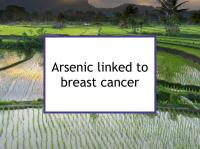Exposure to arsenic has not been well studied as a potential breast cancer risk factor, but evidence is accumulating that it can promote breast cancer. This is based both on cell and epidemiological studies. Now a major Canadian study has reported that women in the highest third of urinary arsenic levels have double the risk of developing breast cancer.
Types of arsenic
Arsenic molecules are characterized as either organic (incorporating carbon) or inorganic (without any carbon atoms). It is inorganic arsenic that is linked to cancer. Low levels of exposure can contribute to increased risks of lung, bladder, skin, and liver cancer, among others. Inorganic arsenic compounds are known to act as environmental estrogens. For example, arsenite has been shown to have estradiol-like effects that activate the estrogen receptor. Unlike cadmium, arsenic does not build up in the body and is eliminated within days.
Sources of arsenic exposure
Arsenic is an element found at low levels in soil, water, and air. It is often found in drinking-water, although most U.S. communities have acceptable levels. Food is the source of most exposure. Plants take up arsenic from the soil and incorporate the element as they grow. While inorganic arsenic is widespread in vegetables, herbs, spices, fruit, grains and seafood, rice and rice products and apple juice can be concentrated sources, depending on their geographic origin. Consumer protections against arsenic in food are weak.
Apple juice
Meaningful levels of arsenic have been found in apple juice produced from apples grown in countries that use certain pesticides no longer approved for use here. Even U.S. organic apples can come from trees grown in soil that may contain arsenic. This is because arsenic-based pesticides were commonly used in the U.S. until 1970, leaving traces that persist in some soils. However, the situation in other countries can be far worse. Unfortunately, it is difficult to determine where the apple juice concentrate used to make juice is sourced. Toddlers and children are the primary consumers of apple juice.
Rice
Rice has more elevated arsenic levels than other grains. Brown rice has higher levels than white rice since arsenic accumulates in the grain's outer layers. Arsenic is contributed both by arsenic in the soil and arsenic in rice field water, much of which is naturally occurring. High levels of arsenic have been reported in rice from areas of the U.S. where former cotton fields have been converted to rice production. Arsenic-based herbicides were used in cotton fields in the early- to mid-20th century. Generally speaking, rice produced in California has lower levels of arsenic than that grown in cotton-belt states such as Arkansas and Louisiana.
Rice labeled organic does not necessarily have low levels of arsenic. Rinsing rice before cooking, using more water (6 cups water to 1 cup rice), and draining the excess water after cooking has been shown to remove approximately 30 % of rice's inorganic arsenic content.
Latest research links arsenic to breast cancer
The Canadian study referenced above was designed to investigate the association between urinary arsenic levels and breast cancer risk. To conduct the study, the authors used 2007-2017 data from the Canadian Health Measures Survey (CHMS), which collects self-reported and objective health measures (including biomonitoring data) from participants every other year.
The study included 5,100 women (average age 44.6 years), who were followed for an average of 6.6 years. High-performance liquid chromatography was used to quantify urinary arsenic levels (µg/L). Participants were at least 18 at the time of urine sample collection and had no personal history of any cancer. Linkage to the Canadian Cancer Registry and the Discharge Abstract Database were used to identify breast cancer cases that arose during the study period.
The median level of urinary arsenic was 7.8 µg/g of creatinine (2.70 µg/g – 84.83 µg/g). Approximately 5% of the women were found to have urinary arsenic levels above the clinically relevant threshold of 50 ug/L. Level of urinary arsenic was divided into tertiles (thirds). Women in the highest tertile (> 13.0 µg/L) had twice the risk of developing breast cancer compared to women in the referent group in age-adjusted models (HR = 2.10; 95%CI 1.06-3.96). Similar results were obtained in models fully adjusted for relevant confounders. The authors conclude that exposure to arsenic, even at low levels, is associated with increased risk of breast cancer.
